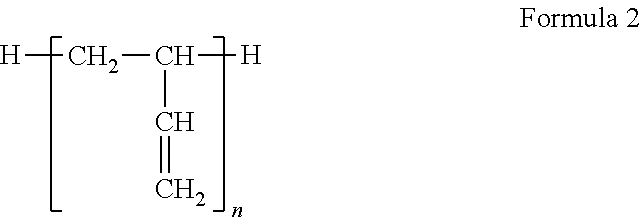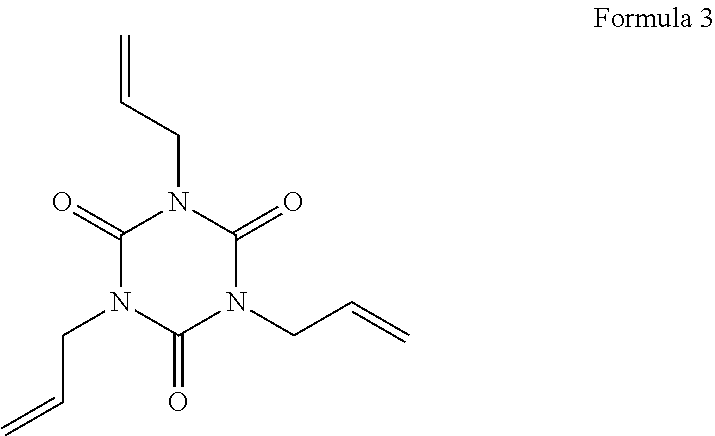Thermosetting resin composition for frequency, and prepreg, laminated sheet and printed circuit board using same
- Summary
- Abstract
- Description
- Claims
- Application Information
AI Technical Summary
Benefits of technology
Problems solved by technology
Method used
Image
Examples
Example
Examples 1 to 3
[0119]1-1. Preparation of Thermosetting Resin Composition
[0120]A thermosetting resin composition was prepared by dissolving the poly(phenylene ether) in toluene according to the composition described in the following Table 1, and then mixing two or more cross-linking curing agents, a flame retardant, and an inorganic filler with the resulting solution, stirring the resulting product for 3 hours, and then adding an initiator thereto, and additionally stirring the resulting product for 1 hour. In the following Table 1, the unit for the amount of each composition used is a part by weight.
[0121]1-2. Preparation of Prepreg and Printed Circuit Board
[0122]A prepreg was prepared by impregnating the prepared resin composition in glass fiber surface-treated with a vinyl group-containing silane coupling agent, and then drying the impregnated glass fiber at 165° C. for about 3 to 10 minutes. Thereafter, a laminated thin plate having a thickness of 0.1 mm was prepared by laminatin...
Example
Comparative Examples 1 to 6
[0123]A resin composition, a prepreg, and a printed circuit board were prepared in the same manner as in the Examples, except for the composition described in the following Table 2. In the following Table 2, the unit for the amount of each composition used is a part by weight.
TABLE 1Example 1Example 2Example 3Allylate PPE404040TAIC81051,2-butadiene85101,9-Decadiene———Di-(4-vinylbenzyl) ether222SBR322Flame retardant999Initiator222Inorganic filler surface-———treated with amino silaneInorganic filler surface-303030treated with vinyl silaneEpoxy Silane G / F———Vinyl Silane G / F∘∘∘1) Allylate PPE: MX-9000 (Number average molecular weight: 2,000 to 3,000)2) 1,2-Butadiene: B-1000 (NIPPON SODA)3) 1,9-decadiene: 1,9-decadiene (EVONIC)4) Styrene-Butadiene: P-1500 (Asahi Kasei Chemical)5) TAIC: TAIC (NIPPON KASEI CHEMICAL)6) Di-(4-vinylbenzyl)ether: BPA-DAE (HAOHUA INDUSTRY)7) Flame retardant: Saytex 8010 (Albemarle Asano Corporation)8) Initiator: Perbutyl P (manufactur...
Example
[0124]Experimental Example 1—Physical Properties of Printed Circuit Board
[0125]On the printed circuit boards prepared in Examples 1 to 3 and Comparative Examples 1 to 6, the following experiments were performed, and the results are shown in the following Table 3.
[0126]1) Measurement of Glass Transition Temperature (Tg)
[0127]The glass transition temperature was measured by DSC 2010 and DSC 2910 manufactured by TA Instruments. About 5 mg of a sample was heated to 300° C. at a rate of 10 / min by using a DSC measuring device, and then cooled to 30° C. at a rate of 10 / min. The first heating / cooling process was carried out twice as the same process.
[0128]2) Coefficient of Thermal Expansion (CTE)
[0129]Measurement of TMA glass transition temperature: The TMA glass transition temperature was evaluated by preparing an evaluation substrate at each side by 5 mm from an evaluation substrate from which a copper foil was removed by impregnating a copper foil laminate with a copper etching liquid, a...
PUM
| Property | Measurement | Unit |
|---|---|---|
| Thermosetting | aaaaa | aaaaa |
| Frequency | aaaaa | aaaaa |
| Content | aaaaa | aaaaa |
Abstract
Description
Claims
Application Information
 Login to View More
Login to View More - R&D
- Intellectual Property
- Life Sciences
- Materials
- Tech Scout
- Unparalleled Data Quality
- Higher Quality Content
- 60% Fewer Hallucinations
Browse by: Latest US Patents, China's latest patents, Technical Efficacy Thesaurus, Application Domain, Technology Topic, Popular Technical Reports.
© 2025 PatSnap. All rights reserved.Legal|Privacy policy|Modern Slavery Act Transparency Statement|Sitemap|About US| Contact US: help@patsnap.com



